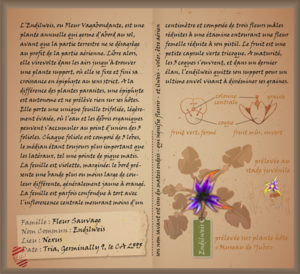From EncyclopAtys
m |
m |
||
| Line 46: | Line 46: | ||
{{Portal|Flora}}{{TIP | {{Portal|Flora}}{{TIP | ||
|DE=1 | |DE=1 | ||
| − | |EN= | + | |EN=4 |
|ES=1 | |ES=1 | ||
|FR=0 | |FR=0 | ||
Revision as of 19:31, 24 August 2019
| Taxonomic Amber | |
| Herbarium written in Avalae[1] dialect | |
|---|---|

| |
| Kingdom | {{{king}}} |
| Category | {{{species}}} |
| Main Ecosystem(s) | Forest, Jungle, Nexus |
| Counterattack type | n.a. |
Description
The endilweis, or roving bloom (also known as iriscea), is an annual plant that germinates first on the ground, before the ground part disintegrates to the benefit of the aerial part. Free then, it twirls in the air until it finds a support plant, where it settles and finishes its growth in epiphyte in the strict sense. Unlike parasitic plants, an epiphyte is autonomous and does not take anything from its hosts.
It has a single trifoliolate leaf, slightly flared, where water and organic debris can accumulate at the point where the three leaflets join. Each leaflet is composed of three lobes, the median always being more important than the lateral ones, like a matis spade point. The leaf is purple, marginated: the edge has a more or less wide band of different colour, usually yellow to orange.
The leaf is sometimes mistaken for the central inflorescence measuring less than one centimetre and composed of three male flowers reduced to a stamen surrounding a female flower reduced to its pistil.
The fruit is a small green tricoque capsule. At maturity, the three hulls open, and in a last impulse, the endilweis leaves its support for a final flight to spread its seeds.
Uses
The leaves, slightly sweet, are used in colored decoctions and very thirst-quenching with an aniseed taste; macerated, they give subtle liqueurs; in poultice, applied on the forehead, they relieve migraines and motion sickness.
The seeds, very aromatic, are used in cooking to flavour fish and delicate meats.
Notes
The endilweis able to move; this is known as “nastic movement”, because it is neither oriented nor dependent on the direction of the stimulus, but determined by the very structure of the leaf which has a small pad (pulvinus) at the base of each of its three leaflets, capable of causing a quick and reversible closure of the leaf on itself, sometimes earning it the nickname of fluttering or else modest flower.
This complex and poorly understood mechanism involves changes in action potentials and the propagation of an electric wave causing acidification follwed by a sudden change in turgidity due to a loss of water in the cells involved in the movement. This phenomenon does not allow it to fly freely, but to impel a first impulse to free itself from its support, reach a favourable wind and then improve its lift in the flight phase, until it reaches a host plant able to welcome it.
The preferred hosts of endilweis are traditionally rainforest plants such as the cardinal fern or the yubo snout, and more recently a hybrid of Rosae Matia : the Rosae Yrkanis.
- ↑ Matis town of the Majestic Garden
| |
| |




